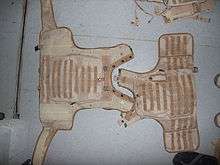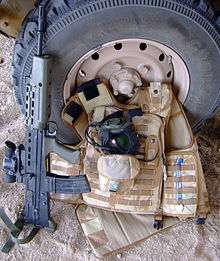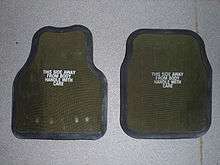Osprey body armour
Osprey body armour is a system of body armour used by the British Armed Forces. The system is in its fourth iteration following extensive development and engagement with front line users.

Heritage
British armed forces have used Combat Body Armour, and then Enhanced Combat Body Armour during Operation Banner, combating terrorist activities in Northern Ireland. ECBA was issued to ground force elements during the early stages of Operation Telic, the invasion of Iraq in 2003.
Following lessons identified in Iraq by both British and American forces the Osprey armour system was released in 2006 for general use. It has subsequently been developed and in late 2010 Version 4 has been issued to personnel serving in Afghanistan on Operation Herrick.
Design
The body armour system is designed and manufactured by CQC Ltd, a long-standing UK based manufacturer for the MOD. The Osprey system is modular and built around a vest which covers the torso. Protective elements to cover the upper arms and around the neck and throat can be added to the main vest. The vest has webbing tape, similar to the Pouch Attachment Ladder System, stitched to the outside to act as a basis for a series of pouches and accessories, removing the need to wear a webbing harness or assault vest over the armour.
The vest consists of a front and rear soft armour panel, which join with the aid of hook & loop fasteners and press studs at the shoulders and waist sides. The panels contain a ceramic trauma plate both front and rear, protected by a rubber surround intended to avoid wear and tear in routine use. Version 4 of the armour introduces additional side panels designed to contain further trauma plates.
Clips on the vest are available for the fitting of a British type Camelbak or Bergen side pouch on the rear, and a respirator haversack on the bottom left.
The armour system is not currently issued to personnel in the UK, and instead retained in theatre, and issued during inward processing. Training is undertaken using earlier versions of Osprey.

Development
Mk 1
Large trauma plates at the front and back with the assembly as described, offering significant improvements over ECBA protection.
Mk 2
The armour was improved by the use of modified pouches, a sling attachment for the rifle and improved construction quality.
Mk 3
Improvements to the armour included the addition of a more robust right hand shoulder assembly, and retaining straps over the side panels to reduce instances of the velcro opening when under stress. This had been mitigated in the Mk 2 armour by the use of a bungee cord around the armour, hooked to the PALS webbing
Mk 4
Introduced in April 2010, this cover was made available in the modified camouflage pattern, Multi-Terrain Pattern, with modifications to the velcro coverage to improve fastening security and an outer cummerbund buckling at the front, rather than the sides. The outer cummerbund also has pockets for trauma plates at the sides. Finally, the most striking change when compared to previous iterations are that the ballistic plates are now contained within the plate carrier, not in an exterior pouch.
System accessories
The Osprey Body Armour is complemented by the Under Body Armour Combat Shirt (UBACS) but can be worn over the CS95 DPM jacket or PCS MTP jacket. The UBACS torso is made of wicking coolmax fabric with soft protection in the shoulders and sleeves.
The pouch system consists of a range of accessories that can be fitted to the vest, allowing an easily configurable load carrying capability that can be tailored to the needs of the individual user. This includes a range of magazine, link, smoke canisters or grenades as well as utility pouches and medical packs.
These accessories are mounted using the PALS tape and can also be fitted to any other equipment with this arrangement, such as the issued MTP 45 Litre patrol daysac [NSN: 8465-99-213-3777].
Criticism
Each generation of Osprey has been subjected to some form of criticism from users and journalists.
Initial criticisms of the first generation were related to the significant increase in weight, and size of the trauma plates, compared with the existing ECBA. Media outlets such as the Daily Mail reported that Royal Marines serving in Afghanistan identified the plates as restricting movement and causing soldiers to be unable to properly use their sights, and were discarding the plates despite the improved personal protection.[1]
The quality of the manufacture of versions 1 and 2 has been criticised with reports of seams and fasteners tearing open in normal use.
First generation pouches were criticised for poor stability on the cover, with some infantry identifying that pouches designed to hold two magazines did not securely hold three, and that the scale of issue was inadequate to hold a standard patrol ammunition load of six magazines.
Virtus
In response to lessons learned in combat, the British Army developed the Virtus personal armour system that offers the same protection as Osprey, but is significantly lighter, moves with the body more easily, and produces a slimmer profile. Virtus is 4.7 kg (10 lb) lighter, and will be even lighter once new armor plates in development are introduced. The level of protection can be increased or decreased depending on the threat environment by adding or removing soft armour pads and hard ballistic plates. Unlike the Osprey's Velcro straps, the Virtus has a chest-positioned pin quick-release mechanism that releases the entire body kit when pulled for safe extraction in hazardous situations. A new, lighter helmet provides increased blunt impact protection, face and mandible guards for certain roles, and a shape designed to work with the armour and daysack so weapons can be comfortably used even in a prone position; it has a permanent universal mount for night vision gear and a scalable counterweight attached to the rear to ease strain on the wearer's neck. The system also eases strain on loads the soldier would be carrying, incorporating the dynamic weight distribution (DWD) integral spine system, which is linked to the waist belt and helps spread the load of the body armour or daysack across the back, shoulders, and hips, which can be adjusted through a hand controller to their preference.[2] Virtus began being issued in May 2016.[3]
Confusion with Kestrel body armour

Various media outlets, including the Ministry of Defence itself, have generated some confusion as to the name of Osprey body armour, often incorrectly labelling it as 'Kestrel' in both photo captions and in article text. This was due to the introduction of limited sets of both types of body armour around the same time in late 2005 and early 2006. Kestrel is a single piece body armour unit, looking like a modified bomb-disposal suit and containing the same small plates as the CBA it replaced. It was issued to troops on 'top-cover' as an Urgent Operational Requirement to provide better protection against the effects of IED detonations, but the design and rigidity of the suit left the wearer almost unable to operate his weapon system. With the issue of collar and arm protectors, often known as 'wings' by troops, with every set of Osprey, Kestrel became redundant and was withdrawn from service in late 2006. With Osprey collars and 'wings' fitted the wearer is still capable of operating weapon systems effectively.
Surplus
After shifting from DPM & DDPM camouflage patterns to MTP, a large number of Osprey Mk 2, 3 & 4 body armour covers & kevlar fillers became available on the European market. They are quite popular with Airsoft players worldwide. In Ukraine, in 2014, due to a lack of adequate protection for members of the Ukrainian Armed Forces participating in the War in Eastern Ukraine, most available Osprey covers there were re-assembled as body armour, using original fillers, and locally- made armour plates. Osprey Mk 4 body armour is extremely popular among Ukrainian military personnel, creating a high demand for it.
References
- ↑ "'British soldiers' £16million body armour so bulky troops must take it off to fire'". Daily Mail. 1 December 2006. Retrieved 7 July 2014.
- ↑ New body armour Virtus for infantry troops of British army to increase agility of soldier - Armyrecognition.com, 11 July 2015
- ↑ The new Virtus body armour system is now issued to the British infantry troops - Armyrecognition.com, 20 May 2016